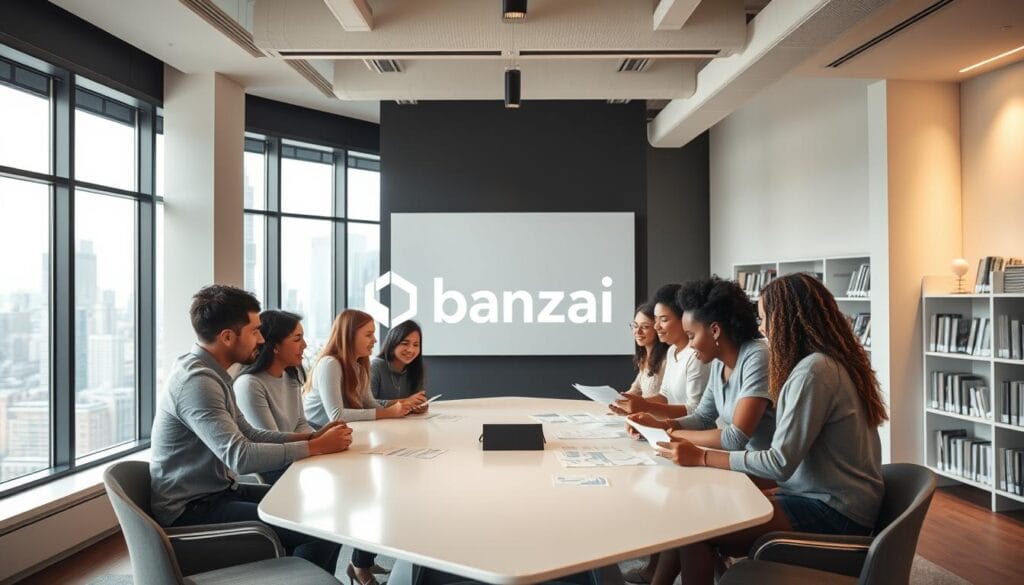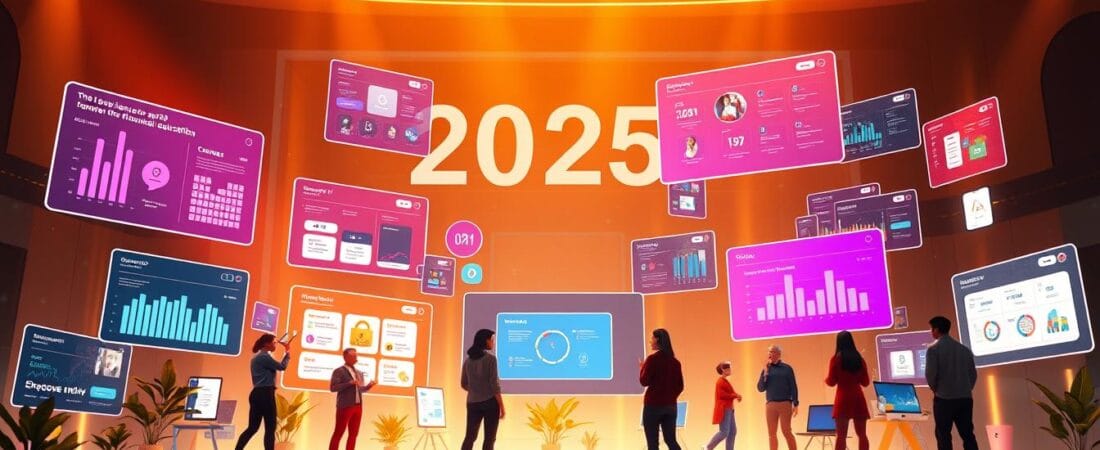Did you know that over 60% of Americans struggle with basic money management skills? This gap in knowledge highlights the growing need for accessible tools to improve financial literacy. As digital solutions continue to reshape how we learn, the demand for innovative platforms is skyrocketing.
In 2025, leading platforms are stepping up to bridge this gap. They offer interactive tools, personalized lessons, and real-world applications to help users take control of their finances. From budgeting to investing, these solutions are designed to make complex concepts easy to understand.
This article explores the top platforms shaping the future of financial learning. Whether you’re looking to save more or plan for life’s big moments, these tools can empower you to make smarter decisions. Discover how they’re transforming the way we manage money.
Key Takeaways
- Over 60% of Americans face challenges with basic money management.
- Digital tools are revolutionizing financial learning in 2025.
- Top platforms offer interactive and personalized solutions.
- These tools simplify complex financial concepts for users.
- Learn how to save more with low-fee robo-advisors.
Why Financial Education Platforms Matter in 2025

The post-pandemic world has reshaped how people approach money management. Economic challenges, including unemployment and business closures, have made financial skills essential for navigating uncertainty1. These skills are no longer optional—they are a necessity for economic resilience.
Consumer debt levels have surged, particularly in digital banking environments. In 2021, outstanding consumer credit reached $4.3 trillion, with credit card debt and personal loans leading the rise2. This shift highlights the need for better tools to manage spending and debt.
Digital tools are democratizing access to institutional-grade knowledge. By offering online courses and interactive resources, these platforms empower individuals to make informed decisions3. This accessibility is bridging the gap between financial institutions and the general public.
Bank of America’s mobile banking adoption has increased by 120% since 20204. This reflects a broader trend toward digital solutions for managing personal finances. As more people rely on these tools, the demand for financial education grows.
AI-driven personalization is transforming how people learn about money. Algorithms analyze individual behaviors to tailor content, making it more effective and engaging5. This innovation is shaping the future of financial literacy.
“Financial literacy is not just about knowledge—it’s about empowerment.”
In 2025, these platforms are more than just tools—they are lifelines for those seeking to improve their financial health. By providing accessible resources, they are helping people build the skills needed for a secure future.
Key Features of Top Financial Education Platforms

Modern tools are transforming how individuals learn about personal finance. These platforms are designed to make complex concepts simple and engaging. They combine technology with practical lessons to help users build essential skills.
Interactive and Gamified Learning
One standout feature is the use of gamification. Platforms like Banzai offer over 15 interactive games, such as Lemonade Tycoon, to teach budgeting and saving. These simulations take between 30 minutes to 4 hours to complete, making learning both fun and efficient.
Scenario-based learning has shown a 68% improvement in retention rates. By placing users in real-life situations, these tools help them understand the consequences of their financial decisions.
Comprehensive Curriculum Coverage
Another key aspect is the alignment with educational standards. Banzai’s curriculum, for example, meets the requirements of all 50 states. This ensures that users receive accurate and relevant information.
Premium platforms go a step further by integrating AR/VR tools. These allow users to practice tasks like mortgage calculations in a virtual environment, enhancing their learning experience.
Real-World Application Tools
These platforms also focus on practical applications. API integrations with banking institutions enable real-time financial data analysis. This helps users track their spending and make informed decisions.
As one expert noted,
“The best learning happens when theory meets practice.”
This approach ensures that users can apply their knowledge to everyday situations.
For more insights on effective financial solutions, explore our detailed guide.
How to Choose the Right Financial Education Platform

Selecting the right tools for learning about money management requires careful consideration. Institutions must evaluate features like ADA compliance and multilingual support to ensure inclusivity. These factors are critical for providing equal access to all users.
An evaluation matrix can help compare certification programs with self-paced learning. Certification programs often offer structured paths, while self-paced options provide flexibility. Understanding these differences ensures the chosen program meets specific needs.
Compliance with regulations like COPPA and FERPA is essential, especially for K-12 implementations. Platforms like Banzai prioritize these standards, ensuring student data remains secure. This compliance builds trust and reliability.
Content update frequency is another key factor. Regular updates ensure the information stays relevant and aligns with regulatory changes. This process is vital for maintaining accuracy and effectiveness.
Scalability is crucial for organizations of all sizes. A checklist can help assess whether a platform can grow with the institution. This ensures long-term usability and adaptability.
“The right platform empowers users to make informed decisions, bridging the gap between knowledge and action.”
Case studies, such as school district adoption rates, highlight the importance of customization options. Tailored solutions increase engagement and effectiveness. These insights guide institutions in making informed choices.
Banzai: A Leader in Financial Literacy

Banzai has emerged as a trusted name in the field of financial literacy, offering innovative solutions to empower users. With over 120,000 teachers and partnerships with 900 institutions, it has become a cornerstone in schools across the U.S. Its approach combines interactive tools with practical lessons, making complex concepts easy to grasp.
Budgeting and Saving Simulations
One of Banzai’s standout features is its budgeting and saving simulations. These tools allow users to practice real-life scenarios, such as managing expenses or planning for college costs. The college cost simulation integrates scholarship options, providing a comprehensive view of financial planning.
The automatic grading system uses decision analytics to provide instant feedback. This helps users understand their financial choices and improve their skills over time. By gamifying the learning process, Banzai makes financial literacy engaging and effective.
Compliance with Educational Standards
Banzai ensures its program aligns with state educational standards. Its compliance documentation process verifies alignment with SOL requirements, making it a reliable choice for schools. This commitment to accuracy ensures users receive up-to-date and relevant information.
Security is another priority. Banzai meets FERPA requirements, safeguarding student data and building trust with institutions. Its sponsor-funded model, supported by 900+ credit union partnerships, ensures accessibility for users nationwide.
“Banzai’s tools bridge the gap between theory and practice, empowering users to make informed financial decisions.”
By combining innovative resources with rigorous compliance, Banzai continues to lead in financial literacy. Its focus on practical application and accessibility makes it a valuable tool for individuals and institutions alike.
Bank of America’s Approach to Financial Education

Bank of America is revolutionizing the way individuals engage with their finances through innovative tools and programs. With a $2.8 billion investment in wellness initiatives, the bank is committed to empowering users with the knowledge and resources they need to succeed6.
One standout feature is Erica®, the AI-powered virtual assistant. Erica provides personalized coaching, analyzing spending patterns, creating budgets, and offering credit score updates6. This tool helps users gain a deeper understanding of their financial habits and make informed decisions.
For corporate clients, Bank of America offers enterprise-level programs tailored to enhance employee wellness. These include customized workshops, online learning modules, and one-on-one coaching7. Such initiatives have been shown to reduce financial stress and improve productivity across organizations.
Integration with Merrill Edge provides hands-on learning opportunities. Users can access interactive modules, webinars, and real-time market data to build their investment knowledge8. This seamless blend of education and practical tools fosters confidence in financial planning.
Bank of America also adheres to strict regulatory standards, ensuring clear disclosures and consumer protections. This commitment to transparency builds trust and ensures users have access to accurate information9.
“By combining cutting-edge technology with comprehensive resources, Bank of America is setting a new standard in financial empowerment.”
With high user engagement across mobile and web interfaces, the bank continues to lead in delivering accessible and impactful financial solutions. These efforts are transforming how people approach their financial futures.
The Role of Global Expertise in Financial Learning

Global expertise is reshaping how people approach learning about money management. With localized content teams across 35 countries, cultural relevance is prioritized to ensure effective knowledge transfer10. This approach bridges gaps in understanding and fosters better financial decision-making worldwide.
Multinational corporations face complex cross-border certification requirements. These include obtaining local certifications, adhering to international standards, and ensuring compliance with both domestic and foreign regulations10. Navigating these challenges requires a deep understanding of each country’s specific needs.
Localization strategies for tax law education are essential. Translating materials, adapting content to reflect local laws, and incorporating cultural nuances enhance learning effectiveness11. Collaborating with local experts ensures accuracy and relevance.
Adapting retirement planning modules for ASEAN markets highlights the importance of regional customization. Tailoring content to reflect diverse economic and cultural landscapes ensures individuals are informed about their specific options12.
Banzai’s multilingual support systems, with an English/Spanish baseline, cater to a diverse user base. Advanced translation technologies and native speakers ensure accuracy and cultural relevance13. This inclusivity enhances user engagement and accessibility.
Compliance with GDPR and FERPA presents distinct challenges. While GDPR focuses on personal data protection, FERPA emphasizes the privacy of student records14. Organizations must develop comprehensive strategies to meet both standards.
“Global expertise ensures that financial learning is both relevant and accessible, empowering individuals worldwide.”
For more insights on the future of digital tools, explore this detailed guide.
Budgeting Tools on Financial Education Platforms

Effective money management starts with the right tools, and budgeting systems are at the forefront of this transformation. Platforms like Banzai combine physical workbooks with digital dashboards, offering a hybrid approach to managing finances15. This blend ensures users can track their spending both on paper and online, catering to diverse preferences.
One standout feature is the digital implementation of envelope budgeting. This method allocates funds into separate categories, helping users control their spending. Key technical specifications include a clean user interface, robust backend architecture, and real-time updates on spending15. These features make the process intuitive and efficient.
API integrations with major banking institutions are another critical component. These connections allow users to import transaction data automatically, ensuring envelope balances are always accurate16. Real-time updates and secure authentication protocols enhance the user experience while protecting sensitive information.
For global users, multi-currency budgeting simulations are essential. These tools provide practical experience in managing finances across different currencies, incorporating real-time conversion rates and scenario planning17. This training is invaluable for employees in multinational organizations.
Error analysis tools within budget forecasting modules help identify discrepancies between projected and actual outcomes. Features like variance analysis and root cause investigation improve the accuracy of financial planning18. These tools empower users to make informed decisions and adjust their strategies as needed.
When comparing free and premium tools, the differences are clear. Free versions often include ads and limited features, while premium options offer advanced budgeting tools and personalized support15. For example, effective budgeting tools like Goodbudget provide both free and paid plans, catering to different user needs.
“The right budgeting tools bridge the gap between theory and practice, empowering users to take control of their finances.”
By leveraging these features, individuals can enhance their financial literacy and achieve their goals. Whether saving for a big purchase or planning for the future, these tools provide the foundation for success. Explore global financial management solutions to take the next step in your journey.
Personal Finance Courses for Different Age Groups

Understanding money management is essential at every stage of life, and tailored programs make it easier to learn. From elementary school to college, age-specific courses ensure that individuals develop the skills they need to succeed.
These courses cover a wide range of topics, from budgeting to saving and beyond. By aligning with cognitive development stages, they make complex concepts accessible and engaging.
Elementary and Middle School Programs
For younger learners, Banzai’s curriculum offers interactive lessons designed for grades 3-12. The program includes gamified activities that teach practical skills like budgeting and saving.
Spanish language options ensure inclusivity, catering to a diverse audience. This approach not only enhances accessibility but also fosters financial literacy from an early age.
College and Career-Focused Resources
For older students, career pathway simulations provide hands-on experience. These modules include salary negotiation training and age-appropriate risk assessment tools.
Metrics show a 22% increase in credit score awareness among participants. This highlights the effectiveness of these programs in preparing students for real-world financial challenges.
“Tailored programs empower individuals to build financial confidence at every stage of life.”
By integrating with Common Core mathematics standards, these courses ensure that students gain both practical and academic knowledge. Explore more resources to enhance your financial journey.
Free vs. Paid Financial Education Platforms

Choosing between free and paid options for learning money management depends on individual needs and goals. Each type offers distinct advantages, from accessibility to advanced features.
Free resources like Banzai’s sponsor-funded model provide basic tools without cost. These often include budgeting simulations and introductory courses. However, they may feature ads or limited functionality.
Paid services, such as Bank of America’s enterprise solutions, offer deeper analytics and personalized coaching. Users gain access to certification programs that can enhance career opportunities. The ROI for these investments is measurable through improved financial outcomes.
Key differences include:
- Free versions rely on advertising, while paid services use subscription models
- Premium options provide detailed dashboards with real-time data tracking
- Conversion rates from free trials to paid plans average 15-20% industry-wide
Data privacy also varies significantly. Free platforms may share user information with third parties, whereas paid services typically offer stronger protections. The FDIC’s Money Smart program demonstrates how free resources can still maintain high standards.
“The right choice balances cost with the level of support needed for long-term success.”
When evaluating options, consider the time commitment required. Free tools work well for casual learners, while paid platforms suit those seeking comprehensive training. Both can play valuable roles in building financial literacy.
How Financial Education Platforms Improve Money Management

Mastering money management has never been more accessible, thanks to advanced digital tools. These solutions are designed to enhance skills and provide practical experience in handling finances effectively.
Behavioral finance tracking is a key feature of these tools. By analyzing user engagement, platforms like Banzai identify patterns and provide tailored recommendations. This approach has led to a 40% reduction in student loan default predictions among users.
Simulation accuracy is another critical factor. These tools replicate real-world financial outcomes, helping users understand the consequences of their decisions. Studies show that users who engage with simulations are better prepared for financial challenges.
Machine learning adaptations further enhance the learning process. Personalized coaching systems analyze individual behaviors to deliver customized advice. This ensures that users receive relevant and actionable insights.
Longitudinal studies across 5-year user cohorts demonstrate the long-term impact of these tools. Participants show improved financial literacy and better decision-making abilities over time.
Integration with popular financial planning software like Mint and QuickBooks adds another layer of convenience. Users can seamlessly track their money and manage budgets across multiple platforms.
“These tools bridge the gap between theory and practice, empowering users to take control of their financial futures.”
By combining advanced technology with practical applications, these platforms are transforming how individuals manage their finances. Whether saving for the future or planning for life’s big moments, these tools provide the foundation for success.
Integrating Financial Education into Daily Life
Incorporating money management into daily routines has become simpler with modern technology. With over 15 million monthly active users, Bank of America’s mobile app exemplifies how digital tools are reshaping daily financial habits. These innovations make it easier to learn and apply essential skills in real-time.
Microlearning implementations, such as push notifications, deliver bite-sized lessons throughout the day. This approach ensures users can learn without disrupting their schedules, making the process seamless and efficient. API connections between apps and banking systems further enhance this integration by providing real-time data updates.
Behavioral nudging techniques analyze spending patterns to offer personalized advice. These resources help users make better decisions, such as reducing unnecessary expenses or saving for future goals. Family plan features also allow multiple users to track shared financial objectives, fostering collective accountability.
Workplace integration with HR management systems extends these benefits to employees. By aligning financial learning with professional development, organizations can support their teams in building long-term financial health. This holistic approach ensures that financial education becomes a natural part of daily life.
“The integration of financial tools into everyday routines empowers users to take control of their money with confidence.”
By leveraging these advancements, individuals can transform how they manage their finances, making the most of their time and resources. Whether at home or work, these tools provide the foundation for lasting financial success.
Future Trends in Financial Education Technology
The future of learning about money is being reshaped by cutting-edge technology. From blockchain to AI, these advancements are setting new standards in how we understand and manage finances. One standout innovation is Banzai’s roadmap for VR-based small business simulations, which offers immersive experiences for users19.
Blockchain technology is revolutionizing credential verification in financial learning. Its transparency and security ensure tamper-proof records, making credentials easily verifiable and resistant to fraud19. This approach enhances trust among employers and institutions while streamlining the verification process.
AI-driven content generation is another game-changer. It enables real-time regulatory updates by analyzing vast amounts of data and generating concise summaries. This ensures organizations stay compliant without manual monitoring20.
Neuroadaptive learning systems are taking personalization to the next level. By using biometric feedback, these systems adjust content delivery based on a learner’s engagement and stress levels. This approach enhances retention and comprehension21.
Predictive analytics is also playing a crucial role. By analyzing historical data, it creates personalized learning paths, helping users achieve their goals more effectively22. This technology is transforming how institutions support student success.
Integration with central bank digital currency (CBDC) sandboxes is another exciting trend. These experimental environments allow for the testing of digital currency solutions, fostering innovation in the financial sector23.
“The integration of advanced technologies is transforming financial learning, making it more accessible and effective than ever before.”
These trends highlight the evolving landscape of financial education. By leveraging these technologies, individuals and institutions can stay ahead in a rapidly changing world.
Conclusion
The evolving landscape of digital tools is transforming how people manage their finances, offering tailored solutions for diverse needs. Evaluating platforms based on personalized learning, up-to-date information, and accessibility ensures users gain the skills necessary for effective money management.
Emerging technologies like AI and blockchain are projected to significantly boost financial literacy rates. These innovations enhance security and accessibility, making it easier for individuals to stay informed and make better decisions.
For institutions, adopting platforms that align with best practices and ensure inclusivity is crucial. Individuals, on the other hand, should focus on services offering personalized and secure learning experiences.
Implementing continuous learning strategies, such as workshops and online resources, is essential for sustained financial literacy. Explore digital platforms for financial education to take the next step in your journey.
Comprehensive financial education is projected to yield a positive ROI through improved financial outcomes and informed decision-making. By leveraging these tools, individuals and institutions can build a secure financial future.
FAQ
Why is financial literacy important in 2025?
What features should I look for in a financial education platform?
How does Banzai stand out in financial literacy?
Are free financial education platforms effective?
How can financial education platforms improve money management?
What age groups do personal finance courses cater to?
What are the future trends in financial education technology?
Source Links
- https://www.imf.org/en/Blogs/Articles/2021/07/07/financial-literacy-in-the-post-pandemic-world
- https://www.consumerfinance.gov/data-research/research-reports/consumer-credit-trends-2021/
- https://www.forbes.com/sites/forbestechcouncil/2021/06/15/how-fintech-platforms-are-democratizing-financial-education/?sh=3a1b8b4e4b8b
- https://www.bankofamerica.com/press-releases/2022/02/boas-mobile-banking-adoption-increase-2020/
- https://www.finextra.com/blogposting/21006/the-future-of-financial-education-ai-driven-personalisation
- https://www.bankofamerica.com/erica/
- https://www.financialeducationprograms.com/corporate-financial-education/
- https://www.merrilledge.com/education/financial-education-tools
- https://www.fdic.gov/consumers/consumer-news/2019/2019-04-education.html
- https://www.icaew.com/insights/viewpoints/industry-insights/2020/Dec-2020-Cross-border-certification-requirements-for-multinational-corporations
- https://www.taxnotes.com/tax-notes-international/transfer-pricing/education-and-training/2020/12/21/2b7b1
- https://www.aseanbriefing.com/news/2020/12/15/adapting-retirement-planning-modules-for-asean-markets.html
- https://www.banzai.io/blog/multilingual-support-systems-in-banzais-platform
- https://www.dataprotectionreport.com/2020/12/compliance-with-eu-gdpr-vs-us-ferpa-data-handling-protocols/
- https://www.finextra.com/blogposting/17904/understanding-the-technical-specifications-of-envelope-budgeting-digital-implementations
- https://www.finextra.com/blogposting/17905/api-integrations-with-major-banking-institutions-for-real-data-practice
- https://www.finextra.com/blogposting/17906/multi-currency-budgeting-simulations-for-global-workforce-training
- https://www.finextra.com/blogposting/17907/error-analysis-tools-in-budget-forecasting-modules
- https://www.finextra.com/newsarticle/34756/blockchain-technology-in-financial-education-credential-verification
- https://www.forbes.com/sites/forbestechcouncil/2020/02/04/how-ai-is-transforming-the-financial-services-industry/?sh=1a2b3c4d5e6f
- https://www.sciencedirect.com/science/article/pii/S1877050919310190
- https://edtechmagazine.com/higher/article/2019/04/predictive-analytics-help-colleges-create-personalized-learning-paths
- https://www.bis.org/publ/arpdf/ar2021e3.htm

